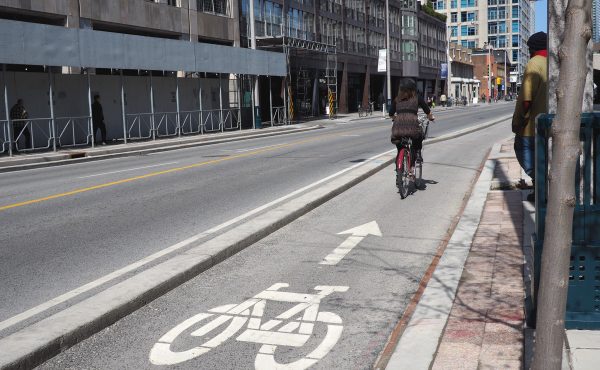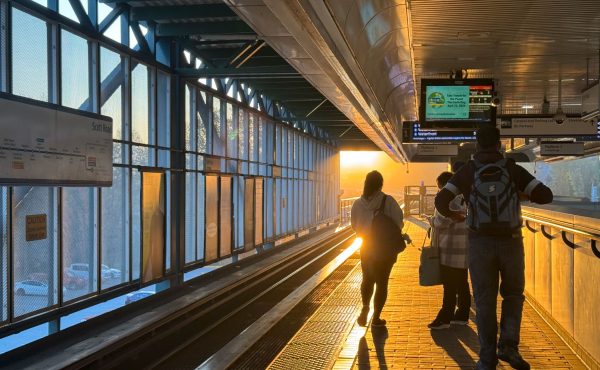
Toronto is once again having a snowy winter, and the City’s Coldest Day of the Year Ride for cyclists is coming up this Friday (January 30). With these things in mind, here are some thoughts on how to tackle the streets on two wheels this season.
Cold. Dark. Ice. Snow. I used to have a hard time wrapping my head around the idea of riding a bike in the dead of winter. Why bother cycling during a deep freeze in the first place? Turns out, there are ways to make it work, and the Cold Weather Cycling guide on the City of Toronto’s website provides plenty of options for cyclists looking to winterize their rides.
Personal taste is a factor, but the website suggests that — though a mountain bike provides good handling — a beater is best for the winter. For Yvonne Bambrick, spokesperson and assistant coordinator for Toronto Cyclists Union, a beater is her best friend all year round. There are also those who prefer different bikes depending on the season. Jonny James, one of the winter cyclists profiled here last winter, uses an old ’80s Fiori Roma road bike with slicks in the snow.
The right tires are essential, according to the City’s guide. It is suggested to lessen tire pressure to increase traction. Thick tires can combat hard packed snow while thin tires are great to cut through slush. And as for your bike locks: keep the key hole well oiled to prevent freezing. Bambrick also says it’s important to keep your chain well oiled. In addition, she recommends mud guards, which can be particularly helpful during the winter because of slush and salt on the roads.
Besides bike equipment, there are other ways to make riding during the winter more pleasant. Bambrick, Jonny James and the City website stress the importance of what you wear. Reflective vests, goggles, and dry and warm attire are crucial components. Jonny James suggests Manzella gloves ($9 @ LeBaron) with gripped pads on the palms and fingers while Bambrick suggests handle bar cosies that act as a wind protector.
Also, safety is always paramount so there’s no shame in going slow. Remember: ride to conditions. If streets are slick, brake sooner and more gently and go easy on the front brake while riding downhill.
Finally. for those of you who are daring and never shake your head at trying new things — no matter how absurd they seem — consider Ktrak.
Born by Kyle Reeves from his Vancouver home, Ktrak was designed to make commuting in a winter wonderland much easier. It’s a kit that transforms your mountain bike into a pedal-powered snowmobile. The universal attachment replaces the wheels of a mountain bike with a track drive and an optional front ski. Start digging through your couch for change, because a full kit will cost about $550; the track alone is roughly $420. It looks insane, but the Ktrak system lets cyclists ride over anything. According to Bambrick, Ktrack is “a great twist on winter fun or sport,†but believes it’s not necessarily an improvement on urban cycling.
Now with the existence of Ktrak, Toronto’s bike lanes don’t have to be ploughed and cyclists can stop complaining, right? Though the kit came out in 2006, there are few GTA residents who own it. Maybe, that’s a good thing, though, since bike lanes really should be cleared regularly. Happy winter cycling.
Photo by Krisztina.




9 comments
Great article! Winter biking is actually quite nice when you’re well equipped. Two things I’d like to add:
1- There needs to be a big gap in-between tires and fenders, otherwise snow gets stuck till you can’t move any further.
2- Tires with spikes are actually very useful. They’re expensive, but you can get away with buying only one (for front tire) or even make your own. There are tutorials around on the web.
Anyone interested in discussing tips and tricks for biking in the winter may be interested in the “How To Bike in the Winter” topic in the BikingToronto Forum. Lots of good stuff in there.
3) Reflective vests aren’t enough. You need good lights, front and rear, attached to the bike and not to your bag or helmet (LEDs have a narrow beam and need to be aimed properly). The biggest danger at night is from cars turning into your path or coming through cross streets, not from overtaking traffic, and a vest won’t help with that.
4) Forget about fashion until April.
I agree with Francis about studded tires… they’re one of the best investments you can make for winter riding.
I had a go at winter cycling this year, but it didn’t pan out. Chalk it up to a lack of preparation, but I left my bike out one night and the next morning the locks, gears and brakes were all seized up. Hot water and some WD40 took care of the gears and locks, but I was 2 blocks down the street before I realized the brakes weren’t working…
A fixed gear and slightly grippy tire is the best way to go in winter. Snow can make brakes completely useless, and deep cold causes freewheels to stop functioning making for a very dangerous combination. A fixed gear allows one to stop without having to completely rely on brakes, and continues to function no matter what the temperature. Also, thin tires cut through slush and snow to give good connection with the road.
There is a reason why the largest proportion of bike messengers (including me) stick with this setup throughout the snowy months.
As far as clothing goes, if you wear wind/waterproof clothing, and layer well all over, biking in the winter can be quite pleasant.
I’ve been couriering all through the winter. The best tip I could give someone thinking of commuting in the winter is – just do it. These “how to bike in the winter” guides are useful, but are sometimes a bit over-the-top and might give some the false impression that they need an ungodly amount of and preparation to get on the road. Really, whatever bike you have now is probably fine for getting to work. The streets on most days will be plowed and clear – just keep an eye out for ice and steer around it. Throw a set of fenders ($25 at MEC – pretty easy to put on) on your bike to keep the snow and slush off your pants and shoes, and make sure you’ve got working lights in the back and front for biking home after the sun’s gone down. That’s all you need, at a basic level. Give your bike a quick wipe-down from time to time to remove salt, and grease your chain regularly (ask the people at MEC how to do this right). Dress the same way you’d dress to do any outdoor sport, like skiing. Don’t be imtimidated!
This is my first winter biking and I’m absolutely loving it. I don’t think I’ve ever enjoyed riding my bike more!
I’ve haven’t had any bad encounters with drivers as of yet even when biking on narrower roads.
Also, I’ve gotten used to people calling me crazy.
Bring back the winter cyclist profiles! They’re great and very inspiring.
I tried to ride all winter but had to stop in January. I was OK with the cold and I didn’t even mind the snow (It’s really just like skiing). What terrified me though was having to deal with cars. You’re in their lane due to large drifts preventing you from keeping over to the side of the road.
If more of the road was plowed you would see a lot more cyclists on the roads in the winter.
The plowed Martin Goodman trail was fantastic as long as you didn’t have to ride in Etobicoke, where it wasn’t maintained. Our roads are plowed for cars. Our sidewalks are shovelled for walking. Why can’t we keep the very small paved areas that bicycles use free of snow as well? It would be a very Canadian thing to do.